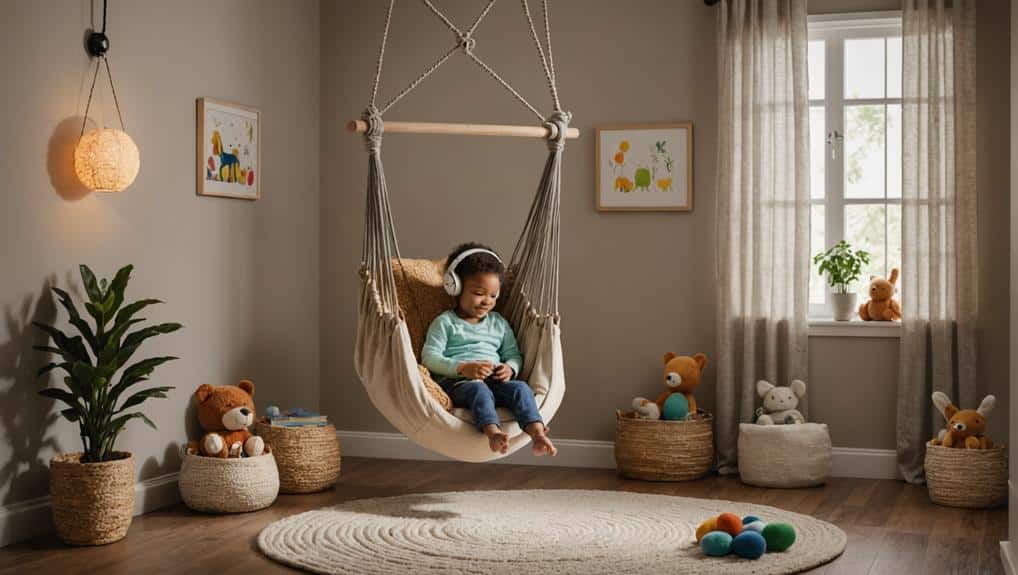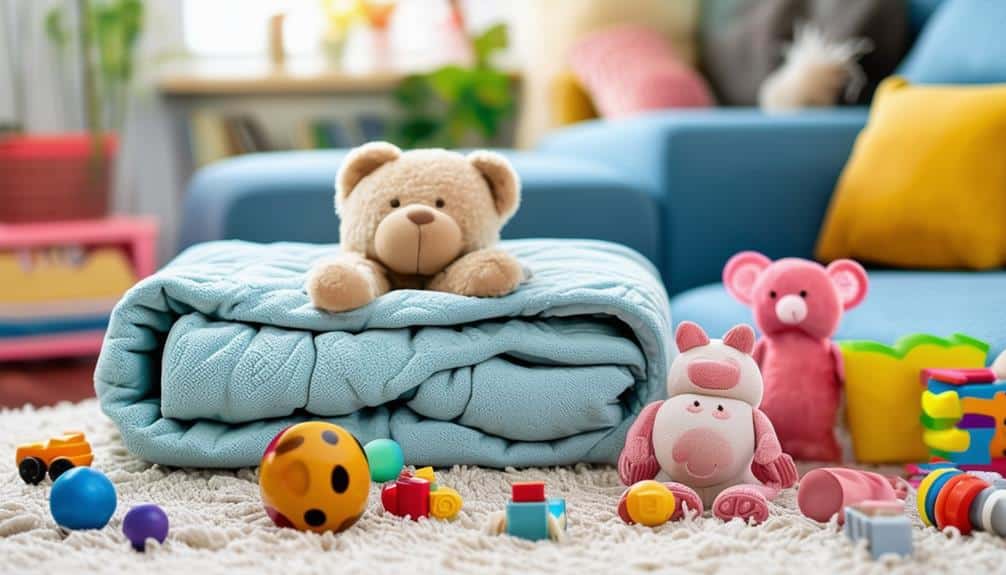Addressing Sensory Processing Disorder (SPD) at home can significantly support the work done in professional therapy. Understanding strategies for sensory processing is critical to helping children feel more comfortable in their environment. Adding simple changes to daily routines and making minor adjustments to your home can create a sensory-friendly space that provides calming pressure, reduces stress, and offers helpful tactile stimulation. These strategies are easy to use and can make a big difference in your child’s ability to manage sensory overload.
In this blog, we’ll explore practical strategies for sensory processing that you can use with everyday household items. From creating cozy spaces to introducing soothing activities, these tips will help you take control of your child’s sensory needs. Are you ready to dive into these effective, at-home techniques? Let’s get started!
Key Takeaways
- Create a secure zone to help children with SPD self-regulate sensory input and find solace when overwhelmed.
- Build a personalized comfort kit to provide tangible support and promote the child’s self-confidence in managing sensory needs.
- Develop a non-verbal sign with the child for discreet communication of sensory needs, improving their self-expression.
- Transition slowly to new environments or experiences, offering previews and advance notices to reduce anxiety and encourage positive responses.
- Based on occupational therapy insights, explore alternatives to provide sensory relief, such as weighted blankets, sensory activities, and chewable jewelry.
Creating a Safe Space
Creating a secure zone is priceless in handling Sensory Processing Disorder (SPD). This area becomes a sanctuary for a child encountering sensory processing challenges, offering them a refuge when their environment becomes overpowering.
In line with therapy techniques for SPD, this area should not only calm but also engage the child’s senses in a balanced manner. By involving the child in the design process, the secure zone becomes a customized haven to which they can relate and feel at ease. This process can encourage the child, giving them a sense of authority over their environment and sensory experiences.
The secure zone should include gentle, adaptable lighting and sound-absorbing materials to regulate sensory input. Sound-muting headphones can provide auditory relief, while tactile items like plush balls or cushions offer comfort and sensory grounding.
It is also crucial to educate others about the purpose and sanctity of the secure zone. This promotes understanding and guarantees the child can use the space without disturbance or invasion.
A well-planned secure zone can markedly assist in handling SPD, allowing the child to self-regulate their sensory input and find solace when overwhelmed.
Building a Comfort Kit
Developing a comfort package offers a tangible source of support for children dealing with Sensory Processing Disorder. This package, usually a fabric tote filled with preferred relaxation tools, provides a convenient resource for handling sensory processing challenges at home and in various settings.
Tailoring the comfort package to a child’s preferences ensures its efficacy. For instance, a child who overreacts to sound, a common indication of Sensory Processing Disorder, may benefit from having noise-canceling headphones in their package. Items like shades, chewing gum, and soothing toys can be included. These items are handpicked based on the child’s sensory needs, addressing their challenges and comforts. This personalization is one of the impactful strategies families can use at home to support their children.
Providing children with their comfort package can instill a sense of security and enablement. This proactive method allows children to have a degree of influence over their experiences, aiding them in navigating overwhelming sensory situations. A comfort package is more than a collection of items – it’s a tool of reassurance, equipping children with the tools they need to manage their sensory needs effectively and confidently. Creating such a package is a practical, empathic step toward promoting well-being.
Establishing a Signal

In the maze of sensory overload, a simple, non-verbal sign can act as a guidepost of self-expression for children with Sensory Processing Disorder (SPD). This sign, whether a hand gesture or a specific facial expression, provides a discreet way for those overwhelmed by sensory input to communicate their sensory needs with dignity and privacy. It can benefit children who struggle with intense reactions to sensory inputs like sound or touch.
- Develop a non-verbal sign: Collaborating with the child to create a sign that resonates with them can nurture a sense of ownership and control over their sensory experiences. This can be part of the occupational therapy techniques used to manage sensory challenges.
- Consistency in use: Once established, consistency in using the sign is critical. This enables the child to express their discomfort proactively, reducing the likelihood of sensory overload and subsequent meltdowns.
- Make it discreet: The sign should be easily recognizable yet unobtrusive, ensuring the child’s privacy is maintained even in public settings.
- Prompt response: Responding promptly to the sign will reinforce its value. This could involve offering a safe space for a retreat or implementing calming strategies.
The sign approach enables children with SPD, offering them a tool for self-expression to alleviate sensory challenges and improve their well-being.
Transitioning Slowly
To effectively manage Sensory Processing Disorder (SPD), it’s vital to approach changes with a gentle touch. Progressing gradually into new environments and experiences can provide a smoother experience for the child, lessening the potential for overwhelm.
In line with occupational therapy strategies, giving the child a preview of the new setting can help them understand what to expect, reduce anxiety, and encourage a positive response. Sensory-based play activities can enhance this approach and be a beneficial tool in cultivating comfort and familiarity.
Advance notice is a critical strategy in this process. This allows the child to mentally prepare for the upcoming change, reducing the shock of sudden adjustments. Introducing new places during quieter times is also beneficial, allowing the child to acclimate to a less overwhelming atmosphere.
Brief visits can also be helpful, as they allow the child to gradually adapt to the new environment’s sights, sounds, and scents. These visits can be extended as the child becomes more comfortable, leading to a more seamless adaptation process.
Exploring Alternatives

Exploring options for managing Sensory Processing Disorder (SPD) requires a flexible approach focusing on the child’s unique sensory needs. This is where occupational therapists’ role becomes vital, as they provide valuable insights and recommendations for effective home implementation of sensory integration strategies. Utilizing a variety of household items can provide visual aids, tactile stimulation, and oral sensory input, maximizing the child’s comfort and reducing stress.
- Weighted Blankets: A comforting tool that can help children facing sensory challenges. The deep pressure input they provide can be calming and grounding.
- Sensory Activities: Implementing activities such as sensory bins can help children discover textures and materials in a controlled, enjoyable environment. This can help reduce stress and enhance tactile stimulation.
- Chewable Jewelry: This is an excellent option for children who seek oral sensory input. Chewable jewelry is stylish and provides a safe, discreet outlet for sensory needs.
- Visual Aids: Using visual cues, such as charts or symbols, can help children understand and manage their routines better, thereby reducing stress.
Frequently Asked Questions
What Are Coping Strategies for Sensory Processing Disorder?
Coping strategies for sensory processing disorder include creating personalized, sensory-friendly environments, utilizing DIY sensory tools and activities, practicing sensory regulation techniques like breathing exercises, and understanding each child’s sensory needs. Guidance and calm behavior modeling are also essential.
How to Do Sensory Integration Therapy at Home?
Sensory integration therapy at home involves tailored activities such as using sensory tools, creating obstacle courses, utilizing sensory bins, applying deep pressure techniques, and incorporating sensory breaks to effectively manage Sensory Processing Disorder.
How to Help Someone With Sensory Processing Disorder?
To aid someone with Sensory Processing Disorder, understand their sensory triggers. Create a sensory-friendly home environment, employ calming techniques, and adopt proactive strategies to anticipate and manage sensory overload. Guidance and patience are paramount.
How to Calm Down a Child With Sensory Processing Disorder?
To calm a child with a sensory processing disorder, introduce deep pressure activities, use sensory tools, create a quiet sensory space, engage in calming exercises, and implement sensory breaks to prevent overwhelming experiences.
Conclusion
To sum up, the effective management of Sensory Processing Disorder demands implementing practical at-home strategies. By establishing a safe space, creating a comfort kit, setting up signals, shifting gently, and exploring alternatives, the quality of life for children with SPD may be significantly improved. While these strategies require conscious effort, the results can be profound, paving the way for improved sensory integration and a well-being era where such interventions are more crucial than ever.


Recent Comments